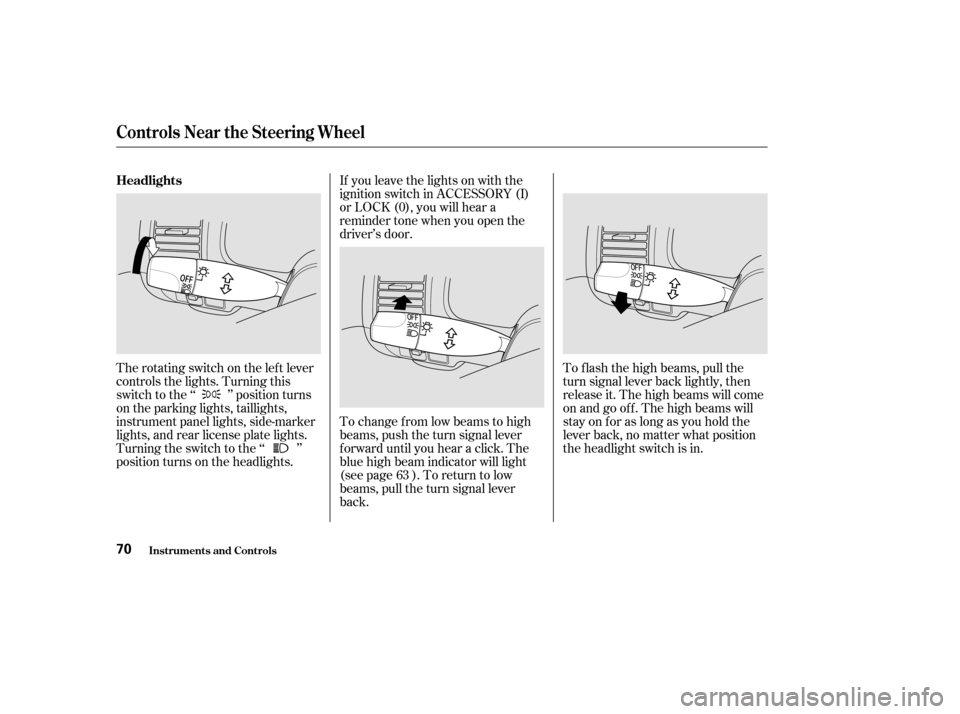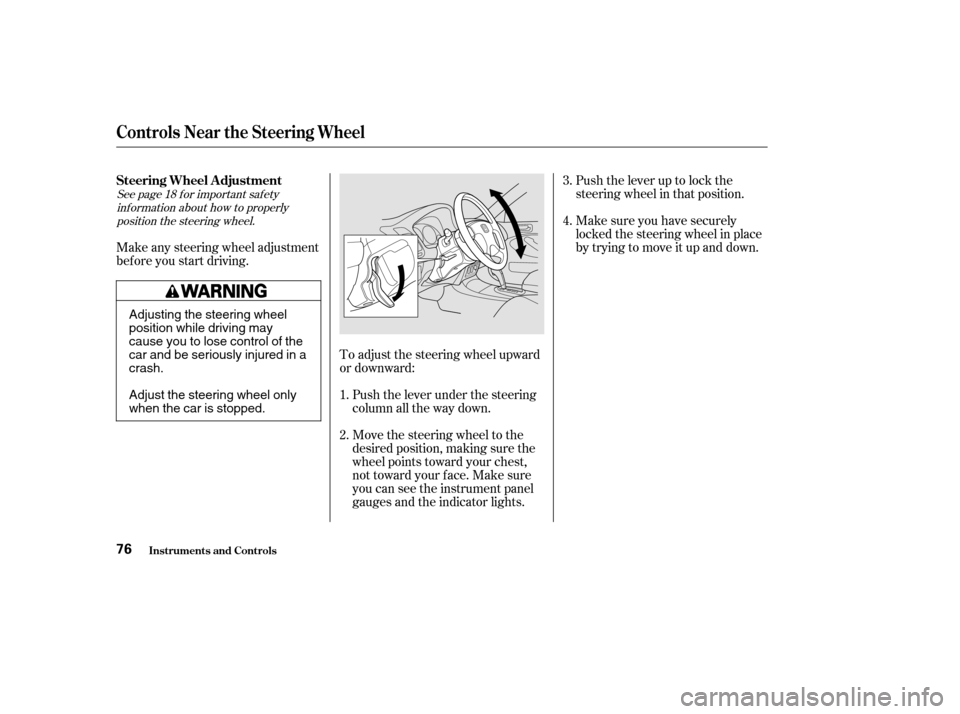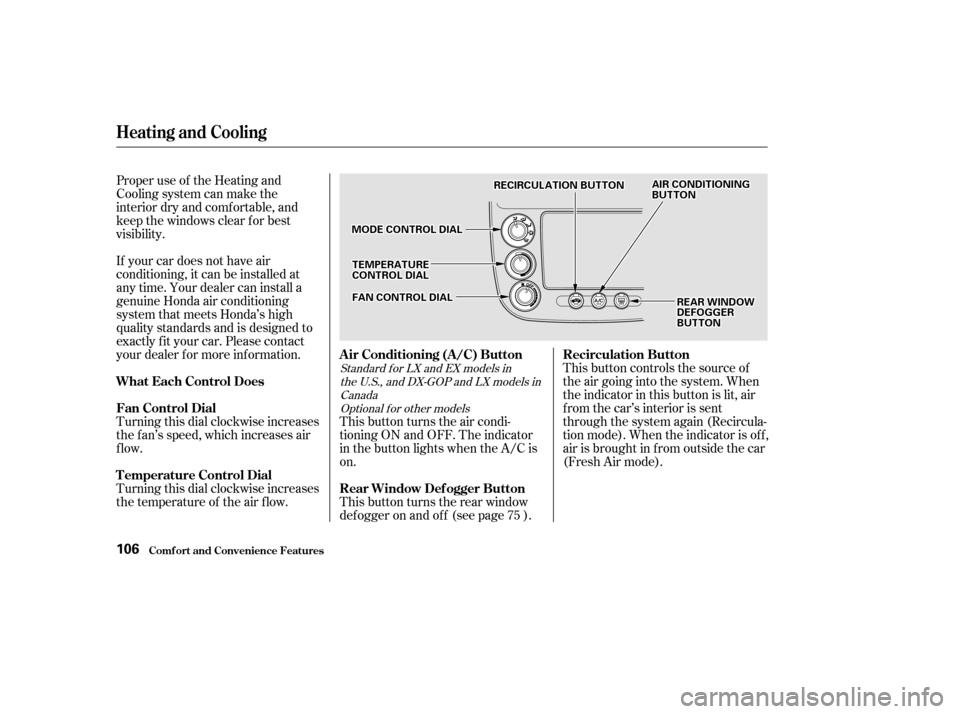2002 HONDA CIVIC Indicator Lights
[x] Cancel search: Indicator LightsPage 56 of 321

This section gives inf ormation about
the controls and displays that
contribute to the daily operation of
your Honda. All the essential
controls are within easy reach............................
Control Locations . 58
...............................
Indicator Lights . 59
.............................................
Gauges . 66
...............................
Speedometer . 66
.................................
Tachometer . 66
...............
Odometer/Trip Meter . 66
..................................
Fuel Gauge . 67
...................
Temperature Gauge . 68
Controls Near the Steering .......................................
Wheel . 69
...................................
Headlights . 70
............
Daytime Running Lights . 71
....
Instrument Panel Brightness . 71
................................
Turn Signals . 72
.....................
Windshield Wipers . 72
..................
Windshield Washers . 74
..........................
Hazard Warning . 74
.............
Rear Window Def ogger . 75
......
Steering Wheel Adjustment . 76
...............................
Keys and Locks . 77
..............................................
Keys . 77
....................
Immobilizer System . 78
............................
Ignition Switch . 80
..................................
Door Locks . 81
......................
Power Door Locks . 82
...................
Remote Transmitter . 83 ..............
Childproof Door Locks . 86
...........................................
Trunk . 86
........
Emergency Trunk Opener . 87
............................
Seat Adjustments . 88
.............
Front Seat Adjustments . 88
Driver’s Seat Height
..............................
Adjustment . 89
................
Driver’s Seat Armrest . 89
..........................
Head Restraints . 90
...........................
Folding Rear Seat . 91
..............................
Power Windows . 93
.........................................
Moonroof . 95
.............................................
Mirrors . 96
....
Adjusting the Power Mirrors . 96
.................................
Parking Brake . 97
........................................
Glove Box . 98
.............................
Beverage Holder . 99
.................
Console Compartment . 100
........................................
Coin Box . 101
...............................
Center Pocket . 101
.............
Accessory Power Socket . 101
...............................
Interior Lights . 102
..............................
Ceiling Light . 102
...................................
Spotlights . 103
..........................
Courtesy Light . 103
Instruments and Controls
Inst rument s and Cont rols57
Page 60 of 321

The instrument panel has many
indicators to give you important
inf ormation about your car.
This indicator lights when you turn
the ignition switch ON (II). It is a
reminder to you and your passengers
to protect yourselves by f astening
the seat belts. A beeper also sounds
if you have not fastened your seat
belt.
If you do not f asten your seat belt,
the beeper will stop af ter a f ew
seconds but the light stays on until
you do. Both the light and the beeper
stay of f if you f asten your seat belt
bef ore turning on the ignition.This indicator lights when you turn
the ignition switch ON (II). If it
comes on at any other time, it
indicates that the passenger’s side
airbag has automatically shut off.
For complete inf ormation, see page
.
This indicator lights when you turn
the ignition switch ON (II). If it
comes on at any other time, it
indicates a potential problem with
your f ront airbags or automatic seat
belt tensioners. On models equipped
with side airbags, this light will also
alert you to a potential problem with
your side airbags or passenger’s side
airbag automatic cut-off system. For
complete inf ormation, see page .
5152
CONT INUED
Only on U.S. models equipped with side
airbags
Indicator L ights
Inst rument s and Cont rols
Seat Belt Reminder L ight Supplemental Restraint
System Indicator
Side A irbag Cut-of f
Indicator
61
Page 62 of 321

This light comes on with the high
beam headlights. See page for
inf ormation on the headlight
controls.
This lights when you set the cruise
control. See page f or inf ormation
on operating the cruise control.
On Canadian models, this indicator
comes on with reduced brightness
when the Daytime Running Lights
(DRL) are on (see page ).
See page .
The lef t or right turn signal light
blinks when you signal a lane change
or turn. If the light does not blink or
blinks rapidly, it usually means one
of the turn signal bulbs is burned out
(see page ). Replace the bulb as
soon as possible, since other drivers
cannot see that you are signalling. This light comes on if the trunk lid is
not closed tightly.
This light comes on as a reminder
that you must ref uel soon.
WhenyouturnontheHazard
Warning switch, both turn signal
lights blink. All turn signals on the
outside of the car should f lash. This light comes on when the
washer f luid level is low. Add washer
f luid when you see this light come on
(see page ).
70
71
281
248 159219
Only on models equipped with Cruise
Control System Canadian models only
High Beam Indicator
Cruise Control Indicator
Malf unction Indicator
Lamp
Turn Signal and
Hazard Warning
Indicators Low Fuel Indicator
Washer Level Indicator
Trunk-open Indicator
Indicator L ights
Inst rument s and Cont rols63
Page 69 of 321

The rotating switch on the lef t lever
controls the lights. Turning this
switch to the ‘‘ ’’ position turns
on the parking lights, taillights,
instrument panel lights, side-marker
lights, and rear license plate lights.
Turning the switch to the ‘‘ ’’
position turns on the headlights.To change f rom low beams to high
beams, push the turn signal lever
f orward until you hear a click. The
blue high beam indicator will light
(see page ). To return to low
beams, pull the turn signal lever
back.
If you leave the lights on with the
ignition switch in ACCESSORY (I)
or LOCK (0), you will hear a
reminder tone when you open the
driver’s door.
To f lash the high beams, pull the
turn signal lever back lightly, then
release it. The high beams will come
on and go of f . The high beams will
stay on f or as long as you hold the
lever back, no matter what position
the headlight switch is in.
63
Headlights
Controls Near the Steering Wheel
Inst rument s and Cont rols70
Page 73 of 321

To clean the windshield, pull back on
the wiper control lever. The washers
spray until you release the lever.Push the button between the center
vents to turn on the hazard warning
lights (f our-way f lashers). This
causes all f our outside turn signals
and both indicators in the instrument
panel to f lash. Use the hazard
warning lights if you need to park in
a dangerous area near heavy traffic,
or if your car is disabled.
The wipers run at low speed while
you’re pulling the lever, then
complete one more sweep of the
windshield af ter you release it.
Controls Near the Steering Wheel
Inst rument s and Cont rols
Windshield Washers
Hazard Warning
74
Page 75 of 321

Push the lever up to lock the
steering wheel in that position.
Make sure you have securely
locked the steering wheel in place
by trying to move it up and down.
Move the steering wheel to the
desired position, making sure the
wheel points toward your chest,
not toward your f ace. Make sure
you can see the instrument panel
gauges and the indicator lights.
Push the lever under the steering
column all the way down.
To adjust the steering wheel upward
or downward:
Make any steering wheel adjustment
bef ore you start driving.
1.4.
3.
2.
See page f or important saf ety inf ormation about how to properlyposition the steering wheel. 18
Steering Wheel A djustment
Controls Near the Steering Wheel
Inst rument s and Cont rols76
Adjusting the steering wheel
position while driving may
cause you to lose control of the
car and be seriously injured in acrash.
Adjust the steering wheel only
when the car is stopped.
Page 105 of 321

Proper use of the Heating and
Cooling system can make the
interior dry and comf ortable, and
keep the windows clear f or best
visibility.
If your car does not have air
conditioning, it can be installed at
any time. Your dealer can install a
genuine Honda air conditioning
system that meets Honda’s high
quality standards and is designed to
exactly f it your car. Please contact
your dealer f or more inf ormation.
Turning this dial clockwise increases
the f an’s speed, which increases air
flow.This button controls the source of
the air going into the system. When
the indicator in this button is lit, air
from the car’s interior is sent
through the system again (Recircula-
tion mode). When the indicator is off,
air is brought in f rom outside the car
(Fresh Air mode).
Turning this dial clockwise increases
the temperature of the air flow. This button turns the air condi-
tioning ON and OFF. The indicator
in the button lights when the A/C ison.
This button turns the rear window
def ogger on and of f (see page ).
75
Standard f or LX and EX models in
the U.S., and DX-GOP and LX models in
CanadaOptional f or other models
Comf ort and Convenience Feat ures
Heating and Cooling
Recirculation Button
What Each Control Does
Fan Control Dial
T emperature Control Dial Air Conditioning (A/C) Button
Rear Window Def ogger Button
106
AAIIRRCCOONNDDIITTIIOONNIINNGGBBUUTTTTOONN
MMOODDEECCOONNTTRROOLLDDIIAALL
RREECCIIRRCCUULLAATTIIOONNBBUUTTTTOONN
RREEAARRWWIINNDDOOWWDDEEFFOOGGGGEERRBBUUTTTTOONN
FFAANNCCOONNTTRROOLLDDIIAALL
TTEEMMPPEERRAATTUURREECCOONNTTRROOLLDDIIAALL
Page 177 of 321

Make sure all windows, mirrors,
and outside lights are clean and
unobstructed. Remove f rost, snow,
or ice.
Check that the hood and trunk are
f ully closed.Make sure the doors are securely
closed and locked.
Check that any items you may be
carrying with you inside are stored
properly or f astened down
securely.
Visually check the tires. If a tire
looks low, use a gauge to check its
pressure. Check the adjustment of the seat
(see page ).
Check the adjustment of the
inside and outside mirrors (see
page ).
Check the adjustment of the
steering wheel (see page ).Turn the ignition switch ON (II).
Check the indicator lights in the
instrument panel.
Start the engine (see page ).
Check the gauges and indicator
lights in the instrument panel (see
page ).
Fasten your seat belt. Check that
your passengers have f astened
their seat belts (see page ).
Youshoulddothefollowingchecks
and adjustments every day bef ore
you drive your car. 1. 2. 3. 4.
9.
10.
8.
7.
6.
5.
11.
12. 16
59
88
96 76 179
Preparing to Drive
Driving178